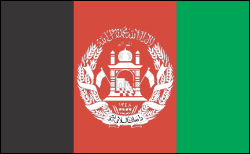Afghanistan History


Ancient History
Darius I and Alexander the Great were the first to use Afghanistan as the gateway to India. Islamic conquerors arrived in the 7th century, and Genghis Khan and Tamerlane followed in the 13th and 14th centuries.
In the 19th century, Afghanistan became a battleground in the rivalry between imperial Britain and czarist Russia for control of Central Asia. Three Anglo-Afghan wars (1839–1842, 1878–1880, and 1919) ended inconclusively. In 1893 Britain established an unofficial border, the Durand Line, separating Afghanistan from British India, and London granted full independence in 1919. Emir Amanullah founded an Afghan monarchy in 1926.
Soviet Invasion
During the cold war, King Mohammed Zahir Shah developed close ties with the Soviet Union, accepting extensive economic assistance from Moscow. He was deposed in 1973 by his cousin Mohammed Daoud, who proclaimed a republic. Daoud was killed in a 1978 coup, and Noor Taraki took power, setting up a Marxist regime. He, in turn, was executed in Sept. 1979, and Hafizullah Amin became president. Amin was killed in Dec. 1979, as the Soviets launched a full-scale invasion of Afghanistan and installed Babrak Karmal as president.
The Soviets, and the Soviet-backed Afghan government, were met with fierce popular resistance. Guerrilla forces, calling themselves mujahideen, pledged a jihad, or holy war, to expel the invaders. Initially armed with outdated weapons, the mujahideen became a focus of U.S. cold war strategy against the Soviet Union, and with Pakistan's help, Washington began funneling sophisticated arms to the resistance. Moscow's troops were soon bogged down in a no-win conflict with determined Afghan fighters. In 1986 Karmal resigned, and was replaced by Mohammad Najibullah. In April 1988 the USSR, U.S., Afghanistan, and Pakistan signed accords calling for an end to outside aid to the warring factions. In return, a Soviet withdrawal took place in Feb. 1989, but the pro-Soviet government of President Najibullah was left in the capital, Kabul.
The Rise of the Taliban
By mid-April 1992 Najibullah was ousted as Islamic rebels advanced on the capital. Almost immediately, the various rebel groups began fighting one another for control. Amid the chaos of competing factions, a group calling itself the Taliban—consisting of Islamic students—seized control of Kabul in Sept. 1996. It imposed harsh fundamentalist laws, including stoning for adultery and severing hands for theft. Women were prohibited from work and school, and they were required to cover themselves from head to foot in public. By fall 1998 the Taliban controlled about 90% of the country and, with its scorched-earth tactics and human rights abuses, had turned itself into an international pariah. Only three countries—Pakistan, Saudi Arabia, and the UAR—recognized the Taliban as Afghanistan's legitimate government.
On Aug. 20, 1998, U.S. cruise missiles struck a terrorist training complex in Afghanistan believed to have been financed by Osama bin Laden, a wealthy Islamic radical sheltered by the Taliban. The U.S. asked for the deportation of Bin Laden, whom it believed was involved in the bombing of the U.S. embassies in Kenya and Tanzania on Aug. 7, 1998. The UN also demanded the Taliban hand over Bin Laden for trial.
In Sept. 2001, legendary guerrilla leader Ahmed Shah Masoud was killed by suicide bombers, a seeming death knell for the anti-Taliban forces, a loosely connected group referred to as the Northern Alliance. Days later, terrorists attacked New York's World Trade Center towers and the Pentagon, and Bin Laden emerged as the primary suspect in the tragedy.
In 2021, the Taliban regained control of Afghanistan (see information below). The situation is ongoing.







